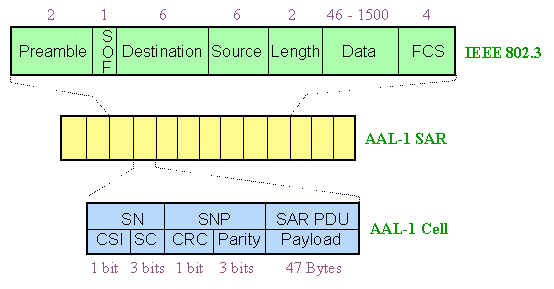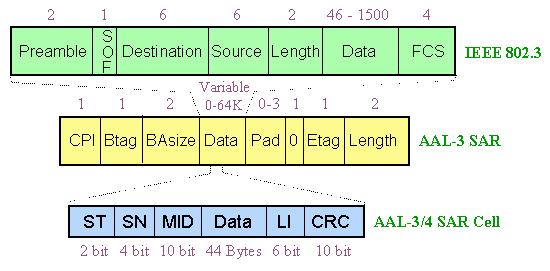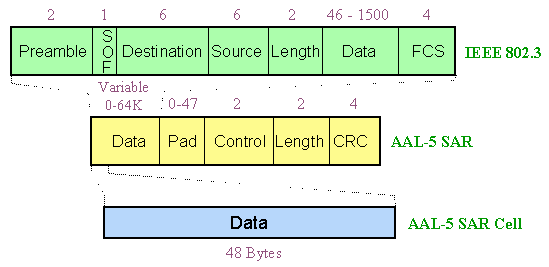|
ATM Adaptation Layer
ATM provides transport of packets from
higher layer protocols which are variable in length and longer
than the 48 payload section of the ATM cell. To have ATM work
in the communications layers, it must segment the larger packets
into multiple ATM cells and later reassemble the multiple cells
back into the original packet. This process is called Segmentation
and Reassembly or SAR for short.
The ATM layer responsible for the SAR
process is the ATM Adaptation Layer or AAL. There are three specified
ways to do this SAR function and they are called AAL-1, AAL-3/4,
and AAL-5.
AAL-1
AAL-1, a connection-oriented service,
is suitable for handling circuit-emulation applications, such
as voice and video conferencing. Circuit-emulation service also
accommodates the attachment of equipment currently using leased
lines to an ATM backbone network. AAL-1 requires timing synchronization
between the source and destination. For this reason, AAL-1 depends
on a medium, such as SONET, that supports clocking.
The AAL-1 process prepares a cell for
transmission in three steps. First, synchronous samples (for example,
1 byte of data at a sampling rate of 125 microseconds) are inserted
into the Payload field. Second, Sequence Number (SN) and Sequence
Number Protection (SNP) fields are added to provide information
that the receiving AAL-1 uses to verify that it has received cells
in the correct order. Third, the remainder of the Payload field
is filled with enough single bytes to equal 48 bytes.
To ensure the cells are reassembled properly,
a sequence number is used. The structure of the AAL-1 PDU is given
in the following illustration.

Figure 1. AAL-1 SAR
Where:
SN
- Sequence number. Numbers the stream of SAR PDUs of a CPCS PDU
(modulo 16).
CSI - Convergence sublayer indicator. Used for residual
time stamp for clocking
SC - Sequence court.
SNP - Sequence number protection.
CRC - Cyclic redundancy check calculated over the SAR header.
Parity - Parity calculated over the CRC.
SAR PDU - payload 47-byte user information field.
AAL-3/4
AAL-3/4 supports both connection-oriented
and connectionless data. It was designed for network service providers
and is closely aligned with Switched Multimegabit Data Service
(SMDS). AAL-3/4 will be used to transmit SMDS packets over an
ATM network.
AAL-3/4 prepares
a cell for transmission in four steps:
-
The convergence sublayer (CS) creates a protocol
data unit (PDU) by prepending a beginning/end tag header to
the frame and appending a length field as a trailer.
-
The segmentation and reassembly (SAR) sublayer
fragments the PDU and prepends a header to it.
-
The SAR sublayer appends a CRC-10 trailer to
each PDU fragment for error control.
-
The completed SAR PDU becomes the Payload field
of an ATM cell to which the ATM layer prepends the standard
ATM header.
An AAL-3/4 SAR PDU header consists of
type, sequence number, and multiplexing identifier fields. Type
fields identify whether a cell is the beginning, continuation,
or end of a message. Sequence number fields identify the order
in which cells should be reassembled. The multiplexing identifier
determines which cells from different traffic sources are interleaved
on the same VCC so that the correct cells are reassembled at the
destination.

Figure 2. AAL-3/4 SAR
AAL-3/4 CS PDU
The basis of AAL-3 is the packet which
is shown in the middle of Figure 2 where:
CPI
- Common part indicator. Represents the units of the BAsize and
length field. A value of only zero indicates bytes
Btag - Beginning tag. This field must have the same value
as Etag for same CPCS-PDUs and a different value as the Btag/Etag
preceding and successive CPCS-PDUs.
BAsize - Buffer allocation size. In message mode this is
equal to the length field. In streaming mode this is equal to
or greater than the length field.
PAD - Up to 3 bytes of padding to achieve 32-bit alignment
in the information field
AL - Alignment. A filling byte coded with zero.
ETAG - End tag. Refer to Btag.
Length - Length of the Information field. This value is
used to indicate information loss or gain.
Functions of AAL-3/4 SAR include identification
of SAR SDUs; error indication and handling; SAR SDU sequence continuity;
and multiplexing and demultiplexing.
AAL-3/4 SAR PDU
The structure of the AAL-3/4 SAR PDU
is shown at the bottom of Figure 2 where:
ST
- Segment type. Values 10 = Beginning of message; 00 = Continuation
of message; 01 = End of message; 11 = Single segment message
SN - Sequence number. Numbers the stream of SAR PDUs of
a CPCS PDU (modulo 16).
MID Multiplexing identification. This is used for multiplexing
several AAL-3/4 connections over one ATM link.
LI - Length indication. Contains the length of the SAR
SDU in bytes
CRC - Cyclic redundancy check calculated over the SAR header.
AAL-5 SAR PDU
AAL-5 is the primary AAL for data and
supports both connection-oriented and connectionless data. It
is used to transfer most non-SMDS data, such as classical IP,
over ATM. AAL-5 also is known as the simple and efficient adaptation
layer (SEAL) because the SAR sublayer simply accepts the CS-PDU
and segments it into 48-octet SAR-PDUs without adding any additional
fields.
AAL-5 prepares
a cell for transmission in three steps:
-
The CS sublayer appends a variable-length pad
and an 8-byte trailer to a frame. The pad ensures that the
resulting PDU falls on the 48-byte boundary of an ATM cell.
The trailer includes the length of the frame and a 32-bit
cyclic redundancy check (CRC) computed across the entire PDU.
This allows the AAL-5 receiving process to detect bit errors,
lost cells, or cells that are out of sequence.
-
The SAR sublayer segments the CS PDU into 48-byte
blocks. A header and trailer are not added (as is in AAL-3/4),
so messages cannot be interleaved.
-
The ATM layer places each block into the Payload
field of an ATM cell. For all cells except the last, a bit
in the Payload Type (PT) field is set to zero to indicate
that the cell is not the last cell in a series that represents
a single frame. For the last cell, the bit in the PT field
is set to one.

Figure 3. AAL-5 Formats
AAL-5 is used to carry computer data
such as TCP/IP. It is the most popular AAL and is sometimes referred
to as SEAL (simple and easy adaptation layer). The basis of AAL-5
is the packet (or SAR PDU) which is composed of the following
fields:
AAL-5 CS PDU
The structure of the AAL-5 CS PDU is
illustrated below in the middle of Figure 3 where:
PAD
- Padding used to cell align the trailer which may be between
0 and 47 bytes long
UU - CPCS user-to-user indication to transfer one byte
of user information.
CPI - Common part indicator is a filling byte (of value
0). This field is to be used in the future for layer management
message indication.
Length - Length of the Information field.
CRC-32 - Cyclic redundancy check computed from the Information
field, PAD, UU, CPI and Length fields. It is a 32-generator polynomial.
AAL-5 SAR PDU
The structure of the AAL-5 SAR PDU consists
of a 48 byte payload and shown at the bottom of Figure 3 which
is just a standard ATM cell.
More Information
The ATMForum has specifications available
at: www.atmforum.com.
Additional ATM seminars:
 An Introduction to ATM - An overview of ATM, the types
of connections, and a description of the various cell formats.
An Introduction to ATM - An overview of ATM, the types
of connections, and a description of the various cell formats.
 ATM Connection Management - A description of how connections
are established, Quality of Service (QoS), and Virtual Connections
(PVCs and SVCs).
ATM Connection Management - A description of how connections
are established, Quality of Service (QoS), and Virtual Connections
(PVCs and SVCs).
In Summary:
-
The ATM Adaptation Layer has several ways to
segment and reassemble packets.
-
The type of AAL used depends on the type of information
needing to be sent.
-
The AAL used also depends on the type of physical
layer transport.
|

